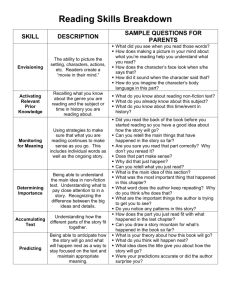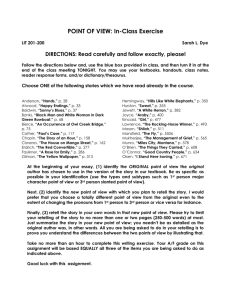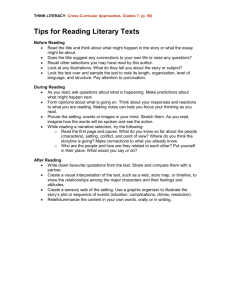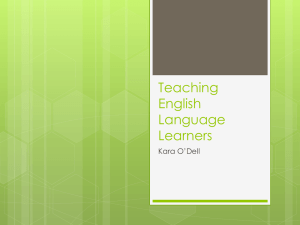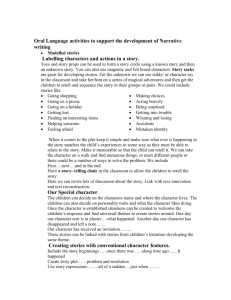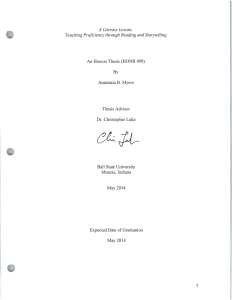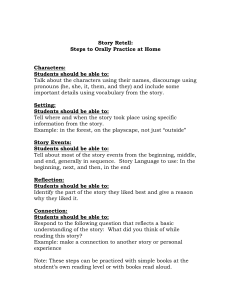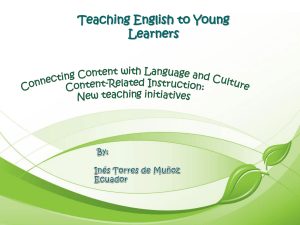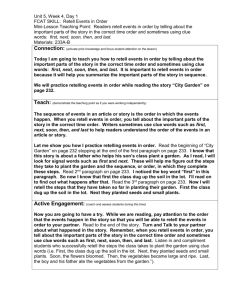WFLTA_Sheehy_TPRS_Pres
advertisement
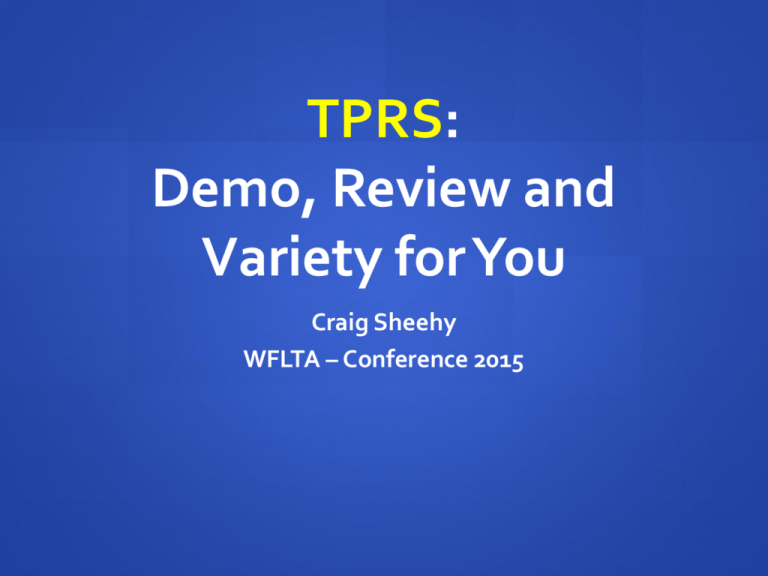
TPRS: Demo, Review and Variety for You Craig Sheehy WFLTA – Conference 2015 A Little Theory Demo Circling / Adding Details Verifying details / Parallel characters Planning a Story Reading and Discussing TPRS and Grading 1 1 1 1 1 Make every minute COUNT!!! 1 Fluency and TPRS® We focus on FLUENCY 1 In order to successfully teach FLUENCY the teacher must: 1. Focus on the context of the input (acquisition) 2. Not focus on the language (learning) 3. Allow students to pick up the language subconsciously 1 TPRS… Uses lessons each day to practice structure because Structure is the key to fluency. 4 What is TPRS®? (Teaching Proficiency through Reading and Storytelling TPRS® is a method of secondlanguage teaching that uses highly-interactive stories to provide comprehensible input and create an atmosphere of scaffolded immersion in the classroom. 1 Three Keys to TPRS/Fluency/Mastery Comprehensible Repetitive Interesting 2 Key 1: Comprehensible Use words students know Speak slowly Edit speech for students SKILLS Point and pause Gestures Visuals 2 Key 2: Repetition SKILLS Repetitive questions (circling) Continually review/start over (recycle) Add details -Multiple locations -Multiple characters -Parallel characters Verify details 2 2 Key 2: Repetition ✓ at any point, stop, go Recycle the Story back, and review the story ✓ re-circle the recycled parts ✓ continue story when you get back to where you left off 2 Key 3: Interest “Playing the game” surprise details Personalization Positive exaggeration Dramatization Dialogue Events 3 4 best results: 1. Teach to the Eyes ✓Teach STUDENTS not curriculum ✓Look in individual student’s eyes when teaching ✓Hold students accountable consistently ✓Always check for understanding 3 Check for mastery 2. Story Retells Have students frequently retell the story to their partners – After the story ends – Have superstar retell story to class – Limit the time to two or three minutes 4 3. Shelter Vocabulary Shelter Vocabulary 50 = 60% 1000=85% Limit vocabulary to a few hundred words per year (using structures) 4 4. Don’t Shelter Grammar Don’t shelter grammar Use whatever grammar is necessary to express meaning that leads to fluency. 4 Is TPRS repetitive? Barb Watson's study Data – TPRS Teacher 5 Data – Control Group Teacher 5 Brain Processing Model E N SIGHT LONG-TERM STORAGE V I TOUCH R O SHORT TERM MEMORY HEARING WORKING MEMORY N SMELL M E N T TASTE PERCEPTUAL REGISTER OUT OUT OUT Sousa, David A.. How the Brain Learns. Thousand Oaks: Corwin Press, 2006. 12 Brain Rules 1. Exercise boosts brain power. 2. The human brain evolved, too. 3. Every brain is wired differently. 4. We don't pay attention to boring things. 5. Repeat to remember. 6. Remember to repeat. 7. Sleep well, think well. 8. Stressed brains don't learn the same way. 9. Stimulate more of the senses. 10. Vision trumps all other senses. 11. Male and female brains are different. 12. We are powerful and natural explorers. 5 DEMO TPRS® PROCEDURES 5 I’m going to tell a story Show me you understand in the following three ways 5 1. I’ll make a statement You respond Interesting statement •“OOOHHH” Something bad •“Oh no, oh no” 5 2. I’ll ask a question where you know the answer. You answer the question with a choral response. 5 3. I’ll ask a question where you don’t know the answer. 1. You guess in the target language 2. Or with proper nouns 3. Try to surprise me 6 Students can respond in 3 ways Strong Response Weak Response Silence 1. Students didn’t understand 2. Students weren’t focused on procedures 3. Students weren’t engaged 6 Solution for weak responses 1. You must be aware of weak responses. 2. You must be sure they understand. 3. Do it again until the students respond correctly. 6 L I ST E N L ook at me I nvolve yourself in the story S how me when you get it or don’t get it T une back in (when your mind wanders aimlessly) E spañol only N o talking over me Es (it) gab (gave) ein Mädchen There was a girl Sie war She was Sie heißt She was named Was? What? Wer? Who? Wie? How? Es gab ein Mädchen There was a girl Was? -What? Sie war - She was Wer? - Who? Sie hatte - She had Wo? - Where? kein - not one oder - or und - and nicht - not ein Hühnchen - A chicken Wie? - How? Warum? - Why? Es gab ein Mädchen There was a girl Sie war She was Was? -What? Wer? - Who? Sie wollte zwei Nasen haben She wanted to have 2 noses Sie ist nach … gegangen She went to … Sie hatte She had Wo? - Where? Wie? - How? kein not one mit with oder or und and Warum? - Why? Circling 6 Circling: the heart of TPRS® 6 Technique 1: Circling the art of asking repetitive questions ✓ start with a statement statement should include structure ✓ ask yes/no question where answer is YES repeat answer: “yes, ...” ✓ ask either/or question repeat answer: “that’s correct, ...” ✓ ask yes/no question where answer is NO repeat answer: “no, ...” restate correct statement ✓ ask question-word question For beginners point to the question word. ✓ Verify the detail. 6 Circling Y E/O N W 1. Positive statement 2. ? with a yes answer 3. Either/or questions 4. ? with a no answer 5. Restate the negative and restate the positive 6. Who? 7. What? Where? When? How? Why? How much?, etc… 8. Positive statement 6 List of necessary skills Translation Gestures Visuals Circling Random order Adding Short explanation Using surprise details From students Of my own A detail Personalizing the story Asking the class Asking the actor Comprehension checks Asking an expert Using dialogue Point and pause Telling a secret Exaggerating positive characteristics Pop up grammar Space between words A location Limiting vocabulary A parallel character A character Using cognates Verifying details With the actor With the class Recycling Coaching actors to overact Embellishing the story with back story (events) From the past From the present From the future Variety is the Spice of Routine Amazing classes – Craig Sheehy You’ve finished the story… NOW WHAT? The story There was a handsome guy named Luke N Forluff. He wanted to have a girlfriend. He went to Chicks R Us and found her. Her name was Anita Mann. She liked him and he was very happy. A Little Variety – LISTENING AFTER THE STORY Listening 1. Profe el Director Loco – retell the story and the kids have to act it out in a certain style (Cowboy, angry Italian, kung fu movie) 2. Charade retell (I tell it, they charade it) 3. Silly Profe - retell wrong, students correct 4. Artista Magnífico – Drawing - 1 box, 4 boxes, 6 boxes 5. La secretaria perfecta - Dictation 6. Rewind - Retell backwards 7. Retell with no questions – Just the Facts baby 8. Fact or Crap - Verdad o tontería 9. Dream, Dream, Dream – I retell, they dream (visualize) 10. Sleep Talker - retell with ?s with eyes closed. The story There was a handsome guy named Luke N Forluff. He wanted to have a girlfriend. He went to Chicks R Us and found her. Her name was Anita Mann. She liked him and he was very happy. A Little Variety – Amazing classes Speaking/writing 1. Around the world in 80 words (word, sentence, paper) 2. Retell charades (I charade, they retell) 3. Telling (adding or subtracting detail, redux, addux) 4. Sing off – Rap off – Story off 5. What do you remember? 6. Unnatural selection retell 7. Repeat last sentence and add the next sentence 8. Balderdash 9. Talk to the hand – Habla a la mano (Canta a la mano) 10.Tell to wall/walking in a circle The story There was a handsome guy named Luke N Forluff. He wanted to have a girlfriend. He went to Chicks R Us and found her. Her name was Anita Mann. She liked him and he was very happy. A Little Variety – Amazing classes Reading 1. Speed Dating/Wagon wheel – Inner Circle pairs with outer circle. 2. Silly Profe –teacher translates wrong, student corrects 3. Narcolepsy/Amnesia 4. FBI decoder - Sentences out-of-order (Textivate?) 5. Papas Calientes or Pass the Buck 6. Readers theater (dramatize) 7. SSR with dictionaries 8. Translation tennis 9. Speed translate 10. Speed read The story There was a handsome guy named Luke N Forluff. He wanted to have a girlfriend. He went to Chicks R Us and found her. Her name was Anita Mann. She liked him and he was very happy. The story There was a handsome guy named Luke N Forluff. He wanted to have a girlfriend. He went to Chicks R Us and found her. Her name was Anita Mann. She liked him and he was very happy. Step One Activities 1. PQA 2. Word Associations 3. Circling with Balls 4. One Word Images 5. Word Chunk Team 6. Look & Discuss 7. Verb Slam Activity 8. Three Ring Circus 9. Visual PQA 10. Class Poem 11. Math Brakes Step Two Activities 1. Stories 2. Super Mini Stories 3. Listen and Draw 4. Sentence Frames 5. Movie Talk -Student version -Reverse -Screenshots -LnD,PQA,Retell,MM 6. Special Chair 7. Star of the Week 8. Two Truths and a Lie 9. Animal Parade Step 3 Activities 1. Textivate 2. Reading Option A 3. Read and Discuss 4. Running Dictation 5. Dictée 6. OWATS 7. Tric a Quiz 8. Free Writes Movie talk 1. Choose a short and simple clip that is just a few minutes in duration. 2. Isolate the (2 or 3) new expressions in the clip that you want to teach. 3. In class, establish meaning of the target structures. 4. Show a few seconds of the video to the class. 5. Freeze the frame and use Look and Discuss to talk about the image. 6. Use the image to do some PQA with the students. 7. Repeat the sequence in steps 4 through 6 throughout the class. 8. Play the video without interruption. 9. Present the reading using Reading Option A. 10. Give the quiz. 1. use 1-3 minute scenes 2. play the scene first (gives you a break and lets the kids see it). 3. explain to the kids that MT is not for entertainment, but to develop listening comprehension. 4. don’t depend on dialogue; pretend you are telling a person who can’t see what’s in the picture.”
